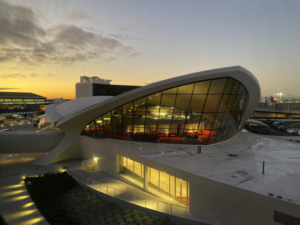No Place Like ‘Drome
There’s no place like home. — Dorothy in the 1939 classic film, The Wizard of Oz
Those who fly probably feel most at home in the sky, preferably in the pointy end of whatever plane we happen to occupy. But the aerodrome* might be a close second.
That is certainly true for me. My earliest memory is flying from Piedmont Triad International Airport (KGSO) in Greensboro to Newark Liberty International Airport (KEWR) on a B-727 “WhisperJet” when I was three years old. I loved the jet, but flying was a rare, special occasion mode of transportation in the mid-1960s. So, for many years the next best thing was Sunday afternoon visits to the airport. I’m not sure how my younger siblings felt — I never thought to inquire — but nothing was more exciting to me than hearing my parents announce a trip to GSO. Once there, we would make our way to the outdoor observation deck and watch the airliners come and go. Even then I was fascinated not only by the airplanes, but also by the well-organized and fast-paced ballet of the people who serviced arriving and departing aircraft.
In those early days of the Jet Age, the mere idea of airports easily conjured a magical mixture of adventure, possibility, and even romance. You’ll find all three in Arthur Hailey’s 1968 book, Airport, which I devoured in my youth. I own all the Airport movies inspired by that novel, and I occasionally treat myself to an airport movie marathon on Friday nights (FWIW, the original still gets my vote for being the best of the bunch). From time to time, I also reread the 1968 novel, if only to marvel at how much the aviation world has changed since then. Who today can imagine a commercial passenger service airport that doesn’t require a security clearance?

If you share any of my fascination for — and appreciation of — the role that airports have played over the years, you might enjoy Alastair Gordon’s quizzically-titled Naked Airport: A Cultural History of the World’s Most Revolutionary Structure. First published in 2004, it opens with pictures and the story of a 1964 visit to New York’s newly renamed John F. Kennedy airport: “the flashy stained-glass entry to American Airlines, the flying-saucer roof of Pan Am” and then the swoopingly modern “birdlike structure” of the TWA terminal. As you may know, the TWA terminal still exists as a boutique hotel offering a unique 1960s throwback experience.
As the prologue to Gordon’s book notes, “The airport is at once a place, a system, a cultural artifact that brings us face-to-face with the advantages as well as the frustrations of modernity. (…) Its history has been a recurrent cycle of anticipation and disappointment, success and failure, innovation and obsolescence. This book traces that history through mutations of technology, design, and marketing — showing how the airport was gradually shaped into a new kind of human environment.”
From the largest air carrier mega-hub to the smallest GA aerodrome, each airport is a precious piece of our national aviation infrastructure. May we never fail to appreciate each one!
*As defined by the International Civil Aviation Organization (ICAO), an aerodrome is “a defined area on land or water (including any buildings, installations, and equipment) intended to be used either wholly or in part for the arrival, departure, and surface movement of aircraft.” Though it is commonly and almost universally used in the United States, the term “airport” may imply a facility that has satisfied certain certification criteria or regulatory requirements. All airports are aerodromes, but not all aerodromes are airports. (FAA Safety Briefing – SepOct 2021)
